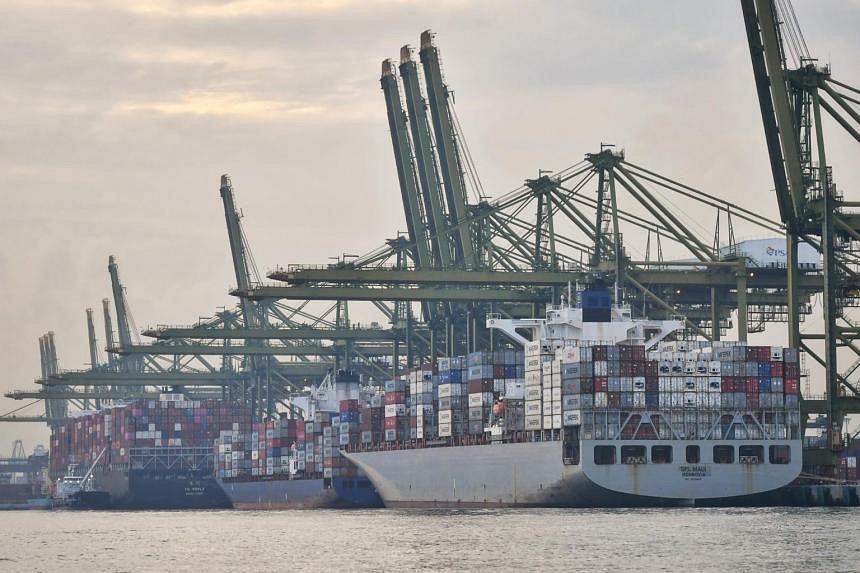SINGAPORE (REUTERS) - Shipping companies are transforming rust buckets into gold mines in a modern-day alchemy that could fuel already rampant inflation for years to come.
The disruption to world trade caused by pandemic lockdowns and a shortage of new cargo vessels has pushed freight rates for ageing container ships to record highs.
Cashing in on the boom, shipping firms are locking in long-term leases lasting three to four years, which means consumers could carry on paying the price for the surge in costs until hundreds of new ships on order come into service.
Take the Synergy Oakland, a mid-sized vessel flagged in Cyprus that can carry more than 4,200 20-foot steel containers. Greek firm Euroseas bought it in 2019 for US$10 million (S$13.8 million) when it was already a decade old.
As world trade spiralled into chaos last year, it raked in US$21 million in just over 100 days at the highest daily freight rate in history for a ship of its size. It squeezed in one more short-term charter earning around US$10 million in the space of two months before going out on a four-year lease for US$61 million in May, a sixfold return in itself on the purchase price three years ago.
"That was almost the perfect play in a rising market," Mr Symeon Pariaros, chief administrative officer of the shipping firm, told Reuters. "We've not seen something like that in the history of the container market."
The world's container ship fleet continued to grow in terms of capacity during the pandemic, rising 2.9 per cent in 2020 after increases of 4 per cent in 2019 and 5.6 per cent in 2018, according to shipping analytics firm Clarksons Research.
But the surge in demand for consumer goods during lockdowns, congestion at ports that tied up ships for longer than expected, and a slowdown in new shipbuilding, partly due to uncertainty about whether vessels would comply with new environmental rules, all contributed to the shipping crunch and record freight costs.
Container capacity jumped 4.5 per cent last year, mainly because ageing ships that might normally be headed for the graveyard kept on sailing, but it hasn't been enough to cool prices yet.
A Reuters review of more than 30 private transactions completed over the last six months showed that ship owners are leasing vessels on long-term charters at record rates to capitalise on the once-in-a-generation bull market. In May, the cost of locking in container shipments soared a staggering 30.1 per cent, a record monthly increase in long-term ocean freight rates, according to Xeneta's ocean freight index.
Record rates have already contributed to higher prices for everything from second-hand cars to dining tables to bicycles, and the pain for consumers is set to continue, experts say.
The International Monetary Fund estimates the container shipping boom in 2021 accounted for 1.5 percentage points of global price rises this year, or about a quarter of the US inflation rate.
While higher food and oil prices in the wake of Russia's occupation of Ukraine feed through to consumer prices within two months, it can take up to a year to feel the full effects of container shipping costs.
"The current still-high freight rates will continue to put pressure on consumer prices well into 2023," said Mr Jan Hoffmann, head of trade logistics at the United Nations Conference on Trade and Development. "I fear that freight rates will remain higher than pre-Covid for many more years."
"Container shipping markets in general remain in extraordinary territory," said Mr Stephen Gordon, managing director of Clarksons Research.
The container shipping industry as a whole made a mind-bending profit of US$59.3 billion in the first quarter this year, shipping expert John McCown said, up from US$19.1 billion in the same period a year ago.
US President Joe Biden said on June 9 that Congress should crack down on the outrageous prices being charged by shipping companies that control the market.
A record 503 second-hand container ships were sold last year, equivalent to 7 per cent of the global fleet, Clarksons said, with another 108 sold in the first five months of 2022.
With no container ships being scrapped this year, the average age of these vessels has risen to 13.9 years from 11 years back in 2017, Clarksons said. That means cargo ships that are 10 or 15 years old, an age at which they were being scrapped before the pandemic, are worth up to 10 times what they were two years ago, sales data shows.
Still, there are signs the boom could come to an end in the next year or two, when many of the giants of the sea ordered by the major companies enter service. In 2021, a record-breaking 555 container vessels worth US$42.5 billion were ordered and 208 vessels worth US$18.4 billion have been booked so far in 2022, according to the World Shipping Council, an industry group based in the United States.

